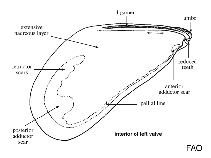Aulacomya atra (Molina,1782)
Chilean ribbed musselGoogle image | No image available for this species;
drawing shows typical species in Mytilidae.
Classification / Names Populärnamn | synonymer | CoL | ITIS | WoRMS
Bivalvia | Mytilida | Mytilidae
Environment: milieu / climate zone / djupintervall / distribution range Ekologi
; djupintervall 0 - 40 m (Ref. 125441). Temperate; 7°C - 16°C (Ref. 78191), preferred 12°C (Ref. 107945); 11°S - 58°S, 78°W - 160°E
Distribution Länder | FAO områden | Ekosystem | Förekomster | Utplanteringar
South Pacific, Southern Atlantic, and Antarctic Indian Ocean: From southern Brazil to Tierra del Fuego in the Atlantic and from Beagle Channel to El Callo, Peru. Also from South Africa to Namibia, Kerguelen and Macquarie Island. Introduced in UK. Tropical to polar.
Length at first maturity / Size / Weight / Age
Könsmognad: Lm ?, range 2 - ? cm Max length : 9.5 cm SHL hane/ej könsbestämd; (Ref. 109255)
Life cycle and mating behavior Könsmognad | Reproduktion | Lek | Eggs | Fecundity | Larvae
Main reference
referenser | Koordinator | Medarbetare
SAUP Database 2006 SAUP Database. www.seaaroundus.org. (Ref. 356)
IUCN Red List Status
(Ref. 130435: Version 2025-1)
CITES status (Ref. 108899)
CMS (Ref. 116361)
Threat to humans
Human uses
Fiskeri: kommersiell
FAO - Vattenbruk: production; fiskeri: landings, species profile | FishSource | Sea Around Us
Verktyg
Ytterligare information
Max. ages / sizes
Length-weight rel.
Length-length rel.
Length-frequencies
Mass conversion
Abundans
Internet-källor
BHL | BOLD Systems | CISTI | DiscoverLife | FAO(fiskeri: species profile; publication : search) | Fishipedia | GenBank (genome, nucleotide) | GloBI | Gomexsi | Google Books | Google Scholar | Google | PubMed | Tree of Life | Wikipedia (Go, sök) | Zoological Record



